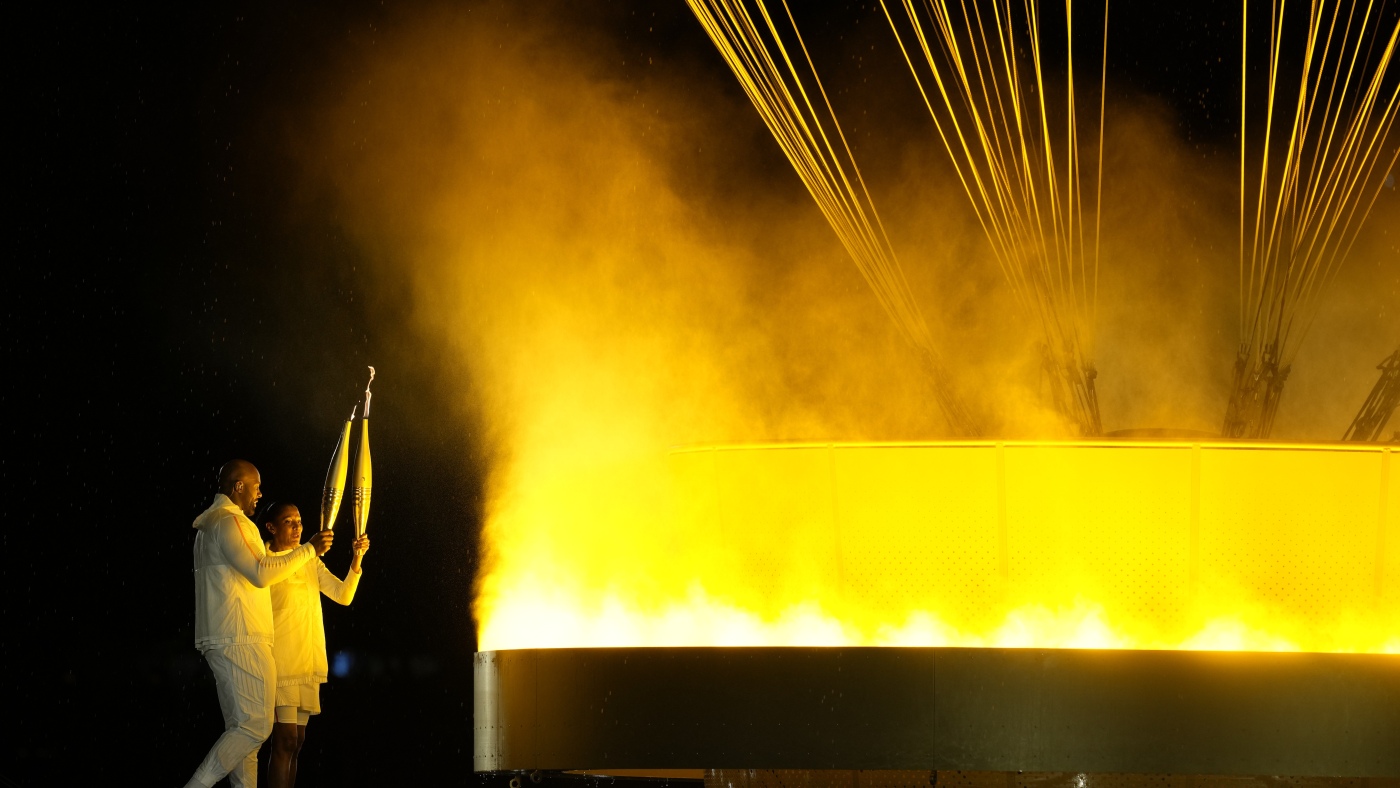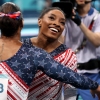The cauldron is lit by torch bearers Marie-Jose Perec and Teddy Riner in Paris, during the opening ceremony of the 2024 Summer Olympics, Friday, July 26, 2024.
Dolores Ochoa/AP
hide caption
toggle caption
Dolores Ochoa/AP
PARIS — You could see it when French gold medalists Marie-José Pérec and Teddy Riner lit the cauldron’s flame together at the finale of the opening ceremony. And when Coco Gauff and Lebron James stood at the bow of the American delegation boat jointly holding the U.S. flag.
These were moments meant to reflect what Olympic organizers are billing as the “gender-equal Olympics.”
That’s in part, the International Olympic Committee says, because this year it has achieved “full gender parity on the field of play,” which it defines as having set a quota to distribute competition spots equally to female and male athletes, with a goal to have female athlete participation at 50% — 2% more than competed in Tokyo in 2021.
The Paris Summer Games are the closest any Olympics has gotten to achieving full gender parity in those terms, however, organizers said that the final tally of female athletes competing could fall short at 49% and it won’t know until the competitions end how that number will bear out.
The international sporting event has made significant progress on this front, compared to the first time women competed in the modern Games in 1900 — when they made up just 2% of athletes.
But IOC’s numbers — which highlight the overall gender composition of athletes — only tell part of the story when it comes to gender equality, said Cheryl Cooky, a professor at Purdue University whose research focuses on the intersections of gender, sport and media.
“There’s a kind of a ‘yes and’ that we need to acknowledge,” she said, “Yes, the IOC has achieved gender parity if we’re looking at this specific indicator or criteria of gender equity, and there are still ways that women athletes are not given the same kinds of quality of opportunities, same types of resources, investments and so on.”
A favorite IOC statistic could overshadow the full gender equality picture
One thing that parity statistic doesn’t show, for example, is the gender participation breakdown by individual delegation, or the conditions under which female athletes participate, said Dunja Antunovic, an assistant professor at University of Minnesota who researches sport, media and gender.
“These sort of generic narratives around meeting gender equality in terms of participation really obscure huge discrepancies and often perhaps prompt us to sort of accept it as an achieved goal as opposed to taking a look at how different delegations compositions might be in terms of gender,” she said. “Some delegations might bring a lot of women to the Olympics, some might not bring women at all.”
Purdue professor Cooky said it’s important to acknowledge that the positive gender equality narrative at the Games is skewed toward the lens of the Global North: “Other countries may not be experiencing the kind of mass wave of support and celebration for their women athletes as we’re seeing here in the United States.”
Although three female athletes are representing Afghanistan in Paris, the nation’s Taliban government — which bars women from participating in sports — only recognizes the three Afghan male athletes on the team. Due to the country’s hostility toward female athletes, IOC’s decision to allow Afghanistan to have a team this Olympics has drawn sharp criticism from some who say that undercuts their own gender equality goals.
“Allowing them to compete for Afghanistan, the I.O.C. is not only undermining its own commitment to Olympic values but also lending legitimacy to the Taliban’s unrecognized regime,” wrote Friba Rezayee, a former judoka Olympian from Afghanistan, in a New York Times op-ed.
The gender gap persists in Olympics leadership
When it comes to the decision-making roles at the Olympics, Antunovic says that, historically, the IOC has not been great at hiring and retaining women in leadership and coaching positions.
The IOC has itself acknowledged that they have work to do there. This year, 42% of coaches are women, according to the organization, about double from what it was at the Olympics 10 years ago. The IOC’s executive board is 33% women, while 42% of its commissions are led by women.
Those positions have power to make decisions that affect gender representation, such as policies on media coverage.
Primetime broadcasts now feature more female Olympians
Organizers concede that female Olympic athletes are still fighting to get equitable coverage in the media, and say they have made changes to support that.
Primetime broadcasts have historically prioritized male athletes. But the IOC has recently shuffled Olympics programming to showcase more women sports during time slots with bigger viewership.
To further promote balanced and inclusive coverage by broadcasters, the organization has issued non-mandatory portrayal guidelines.
Yet in Paris, gender stereotypes have persisted: A day into the Games, a Eurostar commentator made a sexist remark toward an Australian swim team that had just secured a gold medal — and was later dropped by the broadcaster for his comment.
The next day, an IOC official, Olympic Broadcasting Services CEO Yiannis Exarchos warned broadcasters against sexist portrayals of female athletes.
“I still see, unfortunately, in some events, they are still being filmed in a way that you can identify there are stereotypes and sexist remains — even in the way some camera operators are framing differently men and women athletes,” he said. “Women athletes are not there because they are more attractive or sexy or whatever — they are there because they are elite athletes. … they should be showcased in the same way.”
And fair media coverage is important because it garners support for female athletes.
Just ask Flavor Flav. He’s the “official hype man” for Team USA’s women’s water polo squad. At an IOC press conference last week, he said he became a fan and gave an undisclosed amount of money to the team after reading a news story about its need for financial backing.
But, Cooky said, there are only so many Flavor Flavs out there.
“That’s great,” said Cooky. “Let’s celebrate Flav. But what does that mean that we have to have to rely on or look to celebrities or affluent people outside of the Olympic committee context to sponsor women’s sports? What does it mean that athletes are having to work multiple jobs just to make ends meet?”




